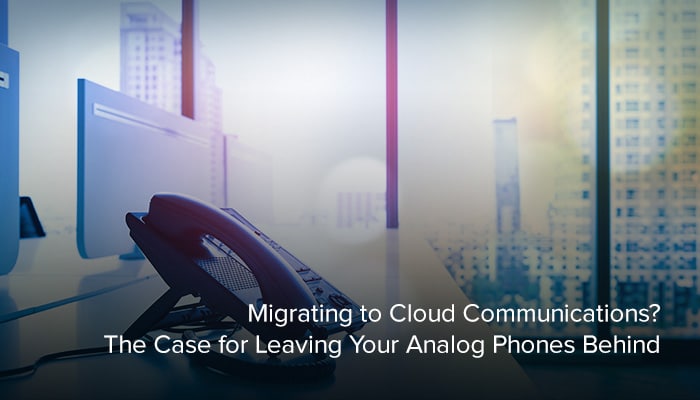
As more and more business applications move to the cloud, an increasing number of enterprises have migrated to cloud communications and collaboration solutions. The reason? These solutions offer the performance, cost benefits, and management capabilities critical to sustainable growth in today’s competitive business environment.
If your enterprise already uses IP phones, the migration process will be seamless as most brands are compatible with the majority of cloud communications providers. You will experience immediate access to full system functionality with a lower up-front capital investment.
On the other hand, if your business currently uses analog phones, you must assess whether to keep the existing equipment or adopt new devices optimized for the cloud.
Understand the costs of remaining analog.
If you think past investments in analog phones makes it too costly to completely replace with IP phones, carefully consider everything that’s required for your analog phones to function with your new cloud system.
Legacy hardware was not designed to be compatible with cloud infrastructure and services. While it may be possible to reuse your existing analog devices, third-party equipment must be installed first. This will require assistance from outside vendors who can install, configure, and maintain this additional equipment.
Even if you choose to purchase, deploy, and maintain this additional equipment, your analog phones will be unable to take advantage of cloud services beyond basic calling functionalities. The limited interaction between cloud systems and analog devices also means your cloud service provider will be unable to provide product support or service for your connected analog phones, requiring additional third-party support.
Still want to keep it analog?
Despite the limitations that come from using analog phones on a cloud communications system, RingCentral realizes that some enterprises will decide to continue using their legacy equipment for various business reasons. In fact, RingCentral is one of the few providers that offers a recommended solution for connecting analog phones to our service.
By deploying an on-premises AudioCodes analog gateway with FXS ports, you can connect multiple analog phones to the RingCentral cloud service. Depending on which gateway is deployed, a maximum of 24 analog phones can be connected to the LAN. All AudioCodes gateways must be configured with individual user endpoint SIP configurations provisioned as third-party devices.
For more information on how to generate a third-party SIP phone configuration in your online service account, click here.
Go with a global cloud communications and collaboration leader: RingCentral.
RingCentral provides enterprise-class cloud communications and collaboration solutions that enable your company to take full advantage of all the benefits a cloud system can offer. In fact, because the RingCentral for Desktop and RingCentral Mobile applications offer access to our full cloud system, you can choose not to install any physical phone equipment at all.
When you’re ready to make your move, RingCentral offers a wide range of state-of-the-art phones and accessories for your new cloud communications system. These specially designed IP and SIP phones offer a host of features, including voicemail, call waiting, call forwarding, and much more. And thanks to our comprehensive onboarding, training, and 24/7 support services, RingCentral will help make your migration to the cloud seamless.
Originally published Dec 19, 2017, updated Jul 23, 2024




